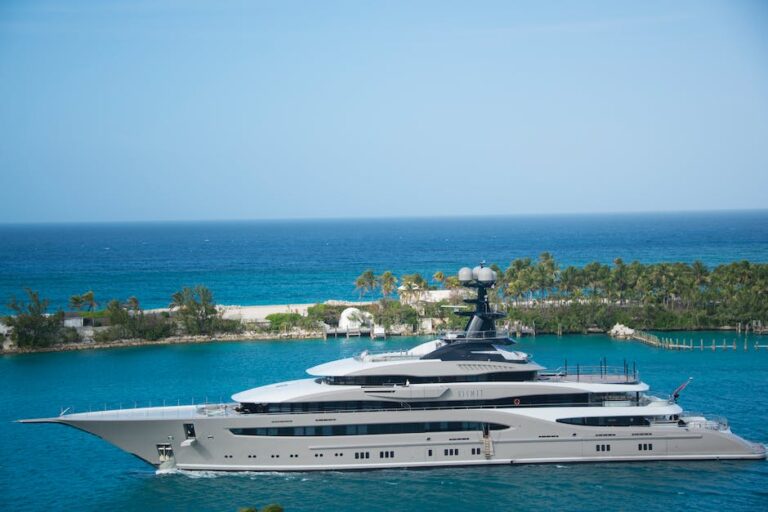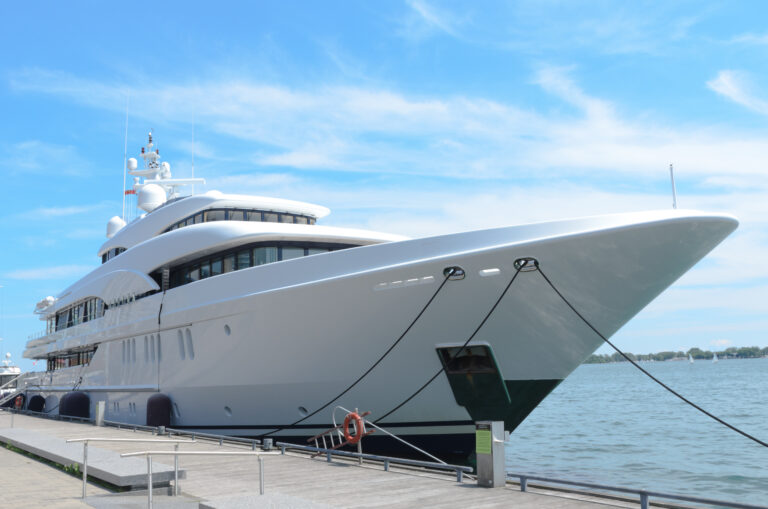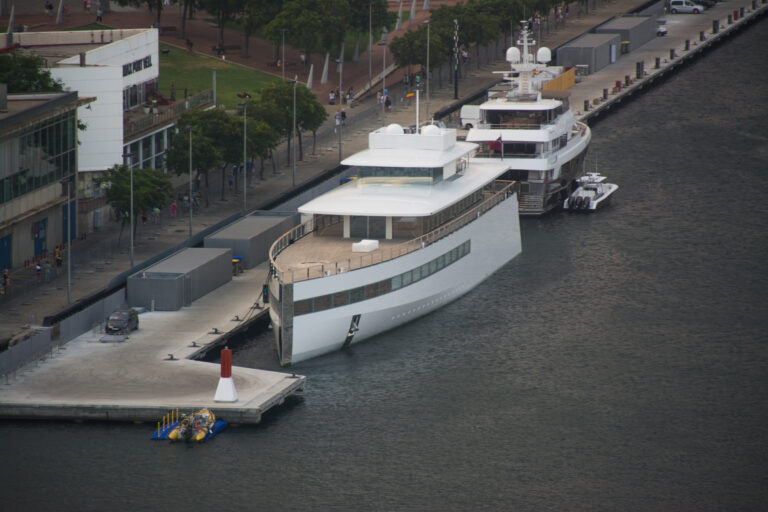What Is the Process of Flagging a Superyacht
In the vast expanse of shimmering seas, where luxury meets opulence, there lies an exclusive world of superyachts. These floating palaces, effortlessly gliding through the waves, are undoubtedly a sight to behold. But have you ever wondered how these majestic vessels come to be registered and granted their prestigious flags? Step aboard as we embark on a journey to unravel the intricate process behind flagging a superyacht. From the captivating allure of international waters to the meticulous procedures of classification societies, prepare to navigate the depths of maritime bureaucracy and glimpse into the hidden realm of yacht registration. Set sail with us as we unveil the cloak of mystique surrounding this fascinating procedure.
Table of Contents
- The Process of Flagging a Superyacht: A Comprehensive Guide
- Exploring the Different Flagging Options for Superyachts
- Understanding the Legal and Administrative Procedures for Flagging a Superyacht
- Factors to Consider When Choosing the Flag State for Your Superyacht
- Ensuring Compliance: Regulations and Requirements for Flagging a Superyacht
- Expert Recommendations for a Smooth Superyacht Flagging Process
- FAQs
- In Summary

The Process of Flagging a Superyacht: A Comprehensive Guide
Flagging a superyacht can be a complex process that requires careful consideration and attention to detail. To ensure a seamless experience, it is essential to follow a comprehensive guide that covers all the necessary steps. Here are some key elements to keep in mind:
- Research: Begin by researching different flagging jurisdictions and their respective regulations. Consider factors such as tax advantages, legal requirements, and reputations within the yachting industry.
- Engage Professionals: Seek the assistance of experienced professionals such as maritime lawyers, yacht management companies, and flagging specialists. They have the expertise to guide you through the process and handle the intricate paperwork involved.
- Documentation: Prepare all the necessary documentation, including proof of ownership, certificates of origin, evidence of compliance with safety regulations, and crew qualifications. Each flag state has its specific requirements, so consult with your professionals to ensure you have gathered the correct paperwork.
- Flag State Application: Submit your application to the chosen flag state. This usually involves completing forms, paying fees, and providing the requested documentation. Again, working with professionals can expedite the process and help avoid any potential delays.
- Inspections and Surveys: Some flag states require inspections and surveys to ensure compliance with safety and operational standards. Prepare your yacht accordingly and schedule any necessary inspections well in advance.
- Flag Change: Once your application is approved, you can officially change the flag of your superyacht. Celebrate this milestone and proudly fly your new flag!
Remember, flagging a superyacht is a significant decision that can have long-term implications. By following this comprehensive guide, you can navigate the process smoothly, ensuring your yacht is properly flagged and compliant with all regulations.
Exploring the Different Flagging Options for Superyachts
Flagging a superyacht is an important decision that can have various implications. Each flag state has its own set of regulations and benefits, making it essential for yacht owners to explore the different flagging options available. Here are some notable choices to consider:
1. Cayman Islands: Renowned for its prestigious reputation in the superyacht industry, the Cayman Islands flag offers a combination of regulatory flexibility and high standards of safety and security. With an efficient system for yacht registration, it provides owners with a reliable and globally recognized flag.
2. Marshall Islands: The Marshall Islands is another popular choice among superyacht owners due to its robust legal framework and favorable tax benefits. This jurisdiction ensures confidentiality and offers comprehensive support services, making it an appealing option for those seeking privacy.
3. Malta: Boasting Europe’s largest register of superyachts, Malta offers a highly reputable flagging option. It provides access to the European market, visa-free travel within the Schengen area, and competitive commercial incentives.
4. Bermuda: Combining the advantages of a reputable British Red Ensign flag with tax-efficient solutions, Bermuda is an attractive choice for superyacht owners. It offers a simplified registration process, excellent maritime infrastructure, and a supportive legal system.
When choosing a flag for your superyacht, it’s crucial to consider factors such as regulatory requirements, tax implications, and the reputation of the flag state. Each flagging option has its own unique features, and it’s worth exploring them to find the best fit for your vessel’s needs and your personal preferences.
Understanding the Legal and Administrative Procedures for Flagging a Superyacht
When it comes to flagging a superyacht, there are several legal and administrative procedures that yacht owners need to navigate. These processes are essential to ensure compliance with international maritime laws and regulations. Here are some key points to understand:
- Choosing the Right Flag State: The first step in flagging a superyacht is selecting the appropriate flag state. This decision involves considering factors such as the jurisdiction’s legal framework, tax benefits, and the yacht’s intended use.
- Compliance with Safety and Navigation Rules: Yacht owners must adhere to safety and navigation regulations set forth by the flag state and international conventions like SOLAS (Safety of Life at Sea). These rules encompass various aspects, including onboard safety equipment, crew training, and navigational requirements.
- Registering the Yacht: The registration process typically involves providing documentation such as ownership proof, builder’s certificate, and evidence of compliance with technical standards. It is also essential to establish a suitable corporate structure and appoint a registered agent in the flag state.
- Annual Renewals and Inspections: After initial registration, superyacht owners need to renew their flag state registration annually. This often requires undergoing inspections to ensure the vessel’s continued compliance with safety standards.
Understanding these legal and administrative procedures is fundamental for those embarking on the adventure of owning a superyacht. By navigating these processes diligently, yacht owners can ensure a smooth flagging experience, guarantee compliance with legal requirements, and enjoy the benefits of sailing their superyacht with peace of mind.
Factors to Consider When Choosing the Flag State for Your Superyacht
When selecting the flag state for your luxurious superyacht, several crucial factors come into play:
- Regulatory Framework: It is vital to focus on the regulatory framework provided by the chosen flag state. Ensuring that the state has a well-established and respected maritime authority can grant peace of mind, knowing that your vessel is subject to consistent and robust standards.
- Tax Benefits: Some flag states offer attractive tax incentives specifically tailored to superyacht owners. Exploring these possibilities can be financially advantageous and worth considering when making your decision.
- Crew Regulations: Different flag states have varying regulations regarding crew qualifications, training, and working conditions. Understanding these regulations helps you ensure that you can recruit and maintain a highly skilled and motivated crew while adhering to legal requirements.
- Privacy and Confidentiality: For those who value privacy, it is essential to choose a flag state that respects and safeguards confidential information. Investigate the state’s privacy laws and ensure they align with your expectations and requirements.
- Political Stability: The political stability of a flag state is a crucial consideration. Opting for a nation with a stable political environment ensures a reliable and consistent framework for yacht operations, minimizing potential disruptions due to political unrest.
By taking these factors into account, you can make an informed decision when selecting the flag state for your superyacht, ensuring a harmonious and prosperous sailing experience.
Ensuring Compliance: Regulations and Requirements for Flagging a Superyacht
When it comes to flagging a superyacht, it is crucial to ensure compliance with the numerous regulations and requirements in place. From safety standards to environmental considerations, these guidelines play a major role in the operation of these luxurious vessels. The flagging process involves several key steps, such as:
- Meeting the strict safety and construction standards set by international maritime organizations.
- Conducting thorough inspections and surveys to verify compliance with regulations.
- Obtaining the necessary certifications and permits, including the International Tonnage Certificate (ITC) and Maritime Mobile Service Identity (MMSI) number.
- Ensuring compliance with applicable environmental regulations, such as the International Convention for the Prevention of Pollution from Ships (MARPOL).
By diligently following these regulations and requirements, superyacht owners and operators can guarantee the safety of their passengers and crew, protect the environment, and maintain a positive reputation within the industry.
Expert Recommendations for a Smooth Superyacht Flagging Process
When it comes to flagging your superyacht, navigating the intricate process can be a daunting task. However, with expert recommendations at your disposal, you can ensure a seamless and hassle-free experience. Here are some valuable tips from industry insiders:
- Choose the right flag state: Selecting the appropriate flag state for your superyacht is crucial. Consider factors like reputation, regulatory standards, and tax benefits associated with each flag state.
- Engage a reputable yacht management company: Entrusting the flagging process to a knowledgeable yacht management company can save you time, effort, and potential pitfalls. They possess the expertise to guide you through the paperwork and legal requirements.
- Familiarize yourself with local regulations: It’s essential to stay informed about the specific regulations and requirements of your chosen flag state. Familiarize yourself with crew qualifications, safety standards, and any additional documentation necessary.
- Ensure proper yacht documentation: Validate that all paperwork, including ownership documents, certificates, and surveys, are up to date and compliant with the flag state’s regulations. This will help avoid delays or complications during the flagging process.
- Seek professional advice: Consulting with professionals experienced in superyacht flagging can provide invaluable insights and guidance. Their expert knowledge can help streamline the process and minimize potential pitfalls.
By following these expert recommendations, you can navigate the superyacht flagging process with confidence, ensuring a smooth journey for your vessel.
FAQs
Q: What is the process of flagging a superyacht?
A: Flagging a superyacht involves the formal registration of the vessel under a specific country’s maritime jurisdiction, known as its flag state. This process includes submitting necessary documentation, adhering to the flag state’s regulations and requirements, and obtaining relevant certifications to ensure the yacht complies with international maritime standards. The chosen flag state will have legal and regulatory authority over the yacht while it operates in international waters, impacting various aspects such as taxation, safety codes, crew qualifications, and more. The decision of which flag state to choose is influenced by factors like the yacht owner’s nationality, operational preferences, and regulatory considerations.
Q: What does it mean to “flag” a superyacht?
A: Just as countries have flags representing their sovereignty, superyachts also fly a flag, indicating the country under whose laws they operate and are registered. Flagging a superyacht essentially means choosing the nation in which the vessel will be registered and displaying its flag proudly while sailing the high seas.
Q: Why is it important to flag a superyacht?
A: The choice of flag plays a significant role in determining the legal and regulatory framework within which a superyacht operates. It affects matters such as taxation, crew certification, safety standards, and commercial chartering options. Additionally, the flag state’s laws and regulations largely govern the yacht’s operation, ensuring compliance with international maritime laws.
Q: How does one choose the flag for a superyacht?
A: Selecting the flag for a superyacht involves careful consideration of several factors. These can include the yacht owner’s nationality, personal preferences, financial and tax considerations, privacy concerns, and the yacht’s intended use, such as private or commercial purposes. A yacht owner may seek advice from professionals specializing in maritime regulations to help make an informed decision.
Q: What is the process for flagging a superyacht?
A: The process of flagging a superyacht can be compared to unfurling a majestic sail. First, the yacht owner must gather necessary documentation, which can include the vessel’s construction records, proof of ownership, and compliance certifications. Then, they typically engage a maritime lawyer or specialized service provider to manage the registration process on their behalf. This involves submitting the required paperwork, ensuring legal compliance, and liaising with relevant maritime authorities.
Q: Are there specific requirements for a yacht to be eligible for a particular flag?
A: Yes, different countries have specific requirements that must be met for a yacht to be eligible for registration under their flag. These requirements can vary widely and may include factors such as the vessel’s size, age, safety equipment, crew certifications, and compliance with international regulations. A maritime lawyer or service provider can guide yacht owners through understanding these criteria and assist in fulfilling the requirements.
Q: Can a superyacht change its flag?
A: Indeed! Just like a vessel changing its course, a superyacht can change its flag if desired. However, changing the flag entails following the specific procedures established by the new flag state. This typically involves deregistering the yacht from the current flag state and complying with the registration requirements of the new flag state.
Q: Are there any advantages or disadvantages in different flag states?
A: Absolutely! Each flag state has its own advantages and disadvantages. Some flags may offer favorable tax regimes, lenient regulations, or attractive yacht-friendly laws. Others may provide an exceptional reputation for safety and security. However, it’s vital to note that choosing a flag should be a well-considered decision, taking into account the yacht owner’s unique circumstances and expectations.
Q: Can a superyacht fly multiple flags?
A: While a superyacht can only legally sail under one flag at a time, it is not uncommon for them to display multiple flags while docked, which often includes the flag of the yacht’s registered state, the owner’s nationality, and any courtesy flags representing the countries visited during the yacht’s voyage.
Q: Is flagging a superyacht a one-time process?
A: Flagging a superyacht is not a one-time process. It requires ongoing compliance with the flag state’s laws and regulations, periodic inspections, and various renewals, such as certificates of seaworthiness and crew qualifications. Yacht owners must ensure their vessel adheres to the flag state’s requirements throughout its operational life.
So, there you have it, shipmates! The captivating process of flagging a superyacht, from choosing a nationality to navigating the legal waters of international regulations. Bon voyage as you unravel the mysteries behind the iconic flags fluttering high atop these magnificent vessels!
To Conclude
As we conclude our journey through the intricacies of flagging a superyacht, we hope you’ve gained valuable insights into this remarkable process. The world of superyachts, with its allure and grandeur, often remains shrouded in mystery. But understanding the steps and considerations involved in flagging a vessel is like unraveling the secrets of an enigmatic treasure chest.
From the shores of the Mediterranean to the turquoise horizons of the Caribbean, the process of flagging a superyacht begins with meticulous planning and comprehensive research. It is a dance between maritime regulations, international conventions, and the aspirations of the owner. Much like the captain navigating the open waters, every decision is carefully measured, guided by an unwavering commitment to excellence and compliance.
As flagging a superyacht requires navigating a complex web of legalities and jurisdictions, choosing the right flag state takes center stage. A delicate balance must be struck between the practical considerations of operating the vessel and the owner’s intentions. Each flag state offers its own unique advantages and considerations, adding a layer of diversity and complexity to the process.
Beyond the selection of a flag state, the technicalities of registration demand meticulous attention. Documentation, surveys, and inspections emerge as milestones to be conquered on the path to acquiring an official yacht registration. The yacht’s classification society closely scrutinizes its construction, safety systems, and other essential aspects to ensure compliance with international standards, cementing its position among the global fleet of superyachts.
Throughout this intricate process, legal and technical experts collaborate harmoniously, crafting a blueprint that will lead the superyacht towards its destiny on the high seas. These professionals, skilled in the ancient art of maritime law, possess an unwavering dedication to steering the vessel into safe waters.
Nonetheless, it is essential to remember that flagging a superyacht is not solely an exercise in bureaucracy, but also an opportunity to manifest the owner’s vision. Cultivating the ethos of a vessel in accordance with the owner’s desires is an art form in itself. The intricacies of personalized customization, from yacht name selection to onboard amenities, merge seamlessly with the technicalities and regulations of flagging, breathing life into the elegant vessel.
As we bid farewell to the vast ocean of knowledge surrounding the process of flagging a superyacht, we hope that our expedition has instilled a deeper understanding of this fascinating world. The realm of superyachts, a realm with no boundaries, invites dreamers and adventurers to embark on a voyage like no other.
So, as the winds of curiosity continue to propel you towards new horizons, we encourage you to explore the enchanting world of superyachts further. Raise the sails of your imagination, and set forth to uncover the treasures that await beyond the shimmering seas.







